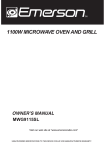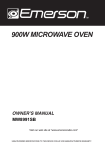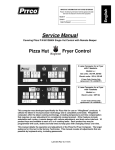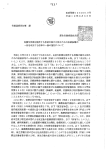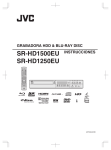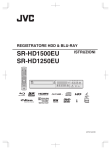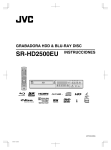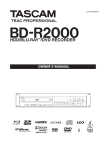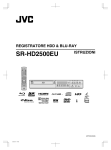Download Emerson 1100W Owner`s manual
Transcript
1100W MICROWAVE OVEN AND GRILL
OWNER’S MANUAL
MWG9115SB
Visit our web site at “www.emersonradio.com”
UNAUTHORIZED MODIFICATIONS TO THIS DEVICE COULD VOID MANUFACTURER'S WARRANTY.
EN
35(&$87,21672$92,'3266,%/(
(;32685( 72(;&(66,9(
0,&52:$9((1(5*<
D 'RQRWDWWHPSWWRRSHUDWHWKLVRYHQZLWKWKHGRRURSHQVLQFHRSHQGRRURSHUDWLRQFDQUHVXOWLQ
KDUPIXOH[SRVXUHWRPLFURZDYHHQHUJ\
,WLVLPSRUWDQWQRWWRGHIHDWRUWDPSHUZLWKWKHVDIHW\LQWHUORFNV
E 'RQRWSODFHDQ\REMHFWEHWZHHQWKHRYHQIURQWIDFHDQGWKHGRRURUDOORZVRLORUFOHDQHUUHVLGXH
WRDFFXPXODWHRQVHDOLQJVXUIDFHV
F 'RQRWRSHUDWHWKHRYHQLILWLVGDPDJHG
,WLVSDUWLFXODUO\LPSRUWDQWWKDWWKHRYHQGRRUFORVHSURSHUO\DQGWKDWWKHUHLVQRGDPDJHWRWKH GRRUEHQWKLQJHVDQGODWFKHVEURNHQRUORRVHQHGGRRUVHDOVDQG
VHDOLQJVXUIDFHV
G 7KH RYHQ VKRXOG QRW EH DGMXVWHG RU UHSDLUHG E\ DQ\RQH H[FHSW SURSHUO\ TXDOLILHG VHUYLFH
SHUVRQQHO
H )RUPRUHVDIHW\WLSVYLVLWIROORZLQJ)'$ZHEVLWH
KWWSZZZIGDJRYFGUKUDGKHDOWKSURGXFWVPLFURZDYHKWPO
%106'065
#WVQ%QQM /GPW%JCTV
/GOQT[
8
%JKNF .QEM
9
+PSWKT[9
%QQMKPI)WKFG20
6JG2TKPEKRNGUQH/KETQYCXG%QQMKPI20
(QQF%JCTCEVGTKUVKEU20
/KETQYCXG 6GEJPKSWGU20
*QV5PCEMUCPF
#RRGVK\GTU1
5GCHQQF1
/GCVU2
2QWNVT [ 22
'IIU%JGGUG3
5QWRU3
8GIGVCDNGU 4
%CUUGTQNGU4
5CWEGU5
5CPFYKEJGU 5
2CUVCCPF)TCKPU 6
%GTGCNU 6
%QPXGPKGPEG (QQFU6
&GUUGTVU7
5RGEKHKECVKQPU8
$GHQTG;QW%CNNHQT5GTXKEG8
.KOKVGF9CTTCPV[9
2TGECWVKQPUVQ#XQKF2QUUKDNG'ZRQUWTGVQ
'ZEGUUKXG/KETQYCXG'PGTI[
+ORQTVCPV5CHGV[+PUVTWEVKQPU
5CHGV[2TGECWVKQPU (GFGTCN%QOOWPKECVKQPU%QOOKUUKQP4CFKQ
(TGSWGPE[+PVGTHGTGPEG5VCVGOGPV
)TQWPFKPI+PUVTWEVKQPU +PUVCNNCVKQP %CTGQH ;QWT/KETQYCXG1XGP *QYVQ7UG ;QWT /KETQYCXG 1XGP 5CHGN[
.QECVKQPQH%QPVTQNU
1RGTCVKQP 5GVVKPI VJG %NQEM
9GKIJV&GHTQUV
6KOG&GHTQUV
2QYGT %QQMKPI+P1PG5VCIG
-KVEJGP6KOGT
%QQMKPIKP 6YQ5VCIGU
&GHTQUVKPI%QQMKPIKP
6YQ5VCIGU
'ZRT GUU %QQM
)TKNNKPI%QQMKPI
%QODKPCVKQP%QQMKPI
#WVQ %QQM
/GCV(WPEVKQP
%JKEMGP/GPW
$GGH /GPW 2QTM /GPW
1
EN
IMPORTANT SAFETY INSTRUCTIONS
8
When using electrical appliances, basic safety
precautions should be followed, including the
following:
WARNING – To reduce the risk of burns, electric
shock, fire, injury to persons, or exposure to
excessive microwave energy:
Do not operate this appliance if it has a
damaged cord or plug, if it is not working
properly, or if it has been damaged or
dropped.
Read all instructions before using this
appliance.
1
2 “PRECAUTIONS TO
AVOID POSSIBLE
EXPOSURE
TO
EXCESSIVE
MICROWAVE
ENERGY”
3
“GROUNDING
INSTRUCTIONS”
Read
and
follow
the
specific
found on page 1.
9
This appliance should be serviced only by
qualified service personnel. Contact the
nearest authorized service facility for
examination, repair or adjustment.
10
11
Do not cover or block any openings on this
appliance.
Do not store or use this appliance outdoors.
Do not use this product near water, for
example, near a kitchen sink, in a wet
basement, or near a swimming pool, or
similar location.
12
13
14
15
Do not immerse cord or plug in water.
16
To reduce the risk of fire in the oven cavity:
This appliance must be grounded. Connect
only to a properly grounded outlet. See
Keep cord away from heated surfaces.
Do not let cord hang over edge of table or
counter.
When cleaning surfaces of door and oven
that come together when closing the door,
use only mild, non-abrasive soaps or
detergents applied with a sponge or soft
cloth.
(a)
Do not overcook food. Carefully attend
appliance if paper, plastic, or other
combustible materials are placed
inside the oven to facilitate cooking.
found on page 5.
4
Install or locate this appliance only in
accordance with the provided installation
instructions.
(b)
Remove wire twist-ties from paper or
plastic bags before placing bag in
oven.
5
Some products such as whole eggs and
sealed containers (for example, closed glass
jars) may explode and should not be heated
in this oven.
(c)
6
Use this appliance only for its intended use
as described in this manual. Do not use
corrosive chemicals or vapors in this
appliance. This type of oven is specifically
designed to heat, cook, or dry food. It is not
designed for industrial or laboratory use.
If materials inside the oven ignite,
keep oven door closed, turn
oven off, and disconnect the power
cord, or shut off power at the fuse or
circuit breaker panel.
(d)
Do not use the cavity for storage
purposes. Do not leave paper
products, cooking utensils, or food in
the cavity when not in use.
7
As with any appliance, close supervision is
necessary when used by children.
17
Do not use this microwave oven to heat
corrosive chemicals (for example, sulfides
and chlorides). Vapors from such corrosive
chemicals may interact with the contact and
FOR HOUSEHOLD USE ONLY .
SAVE THESE INSTRUCTIONS
2
EN
IMPORTANT SAFETY INSTRUCTIONS
springs of the safety interlock switches,
thereby rendering them inoperable.
18
19
WHEN THE CONTAINER IS DISTURBED
OR A UTENSIL IS INSERTED INTO THE
LIQUID. To reduce the risk of injury to
persons:
Keep the spatter shield clean at all times.
Wipe the oven interior with a soft damp cloth
after each use. If you leave grease or fat
anywhere in the cavity it may overheat, smoke
or even catch fire when next using the oven.
(a)
(b)
Do not overheat the liquid.
Stir the liquid both before and
halfway through heating it.
(c) Do not use straight-sided containers
with narrow necks.
(d) After heating, allow the container to
stand in the microwave oven for a short
time before removing the container.
( e ) Use extreme care when inserting a
spoon or other utensil into the container.
Liquids, such as water, coffee, or tea are able
to be overheated beyond the boiling point
without appearing to be boiling due to
surface tension of the liquid. Visible bubbling
or boiling when container is removed from
the microwave oven is not always present.
THIS COULD RESULT IN VERY HOT
LIQUIDS SUDDENLY BOILING OVER
FOR HOUSEHOLD USE ONLY .
SAVE THESE INSTRUCTIONS
SAFETY PRECAUTIONS
General Use
1
2
3
Do NOT attempt to tamper with or make any
adjustments or repairs to door, control panel or
any other part of the oven. Do NOT remove
outer panel from oven. Repairs should only be
done by qualified service personnel.
Do NOT operate the oven empty. The
microwave energy will reflect continuously
throughout the oven if no food or water is
present to absorb energy.
If a fire occurs in the oven, touch the
Stop/Clear button and LEAVE THE DOOR
CLOSED. Disconnect the power cord, or shut
off power at the fuse or circuit breaker panel.
4
Do NOT attempt to dry clothes, newspapers or
other materials in the oven. They may catch on
fire.
5
Do NOT use recycled paper products.
Recycled paper towels, napkins and waxed
paper can contain metal flecks which may
cause arcing or ignite. Paper products
containing nylon or nylon filaments should be
avoided, as they may ignite.
6
Some styrofoam trays (like those that meat is
packaged on) have a thin strip of metal
embedded on the bottom. When microwaved,
the metal can burn the floor of the oven or
ignite a paper towel.
7
Avoid inserting nails, wire, etc. through any
holes in the unit during operation. Never insert
a wire, nail or any other metal objects through
the holes on the cavity or any other holes or
gaps, because such objects may cause
electric shock and microwave leakage.
Utensils
1
2
3
4
5
6
7
8
METAL CONTAINERS or dishes with metallic
rims should not be used. Arcing may occur.
METAL TWIST-TIES may not be used in the
microwave oven.
Do NOT use SEALED JARS or NARROW
NECK bottles for cooking or reheating. They
may shatter.
Do NOT use CONVENTIONAL THERMOMETERS in the microwave oven. They
may cause arcing.
Remove PLASTIC STORE WRAPS before
cooking or defrosting foods in the oven.
Use microwave-safe utensils for microwave
cooking.
Use the provided grill rack and a microwavesafe, ovenproof baking dish for grill cooking.
For FURTHER INFORMATION on proper
cooking utensils, refer to the COOKING
GUIDE on page 19.
Food
1
Never use your microwave oven for HOME
CANNING. The oven is not designed to permit
proper canning. Improperly canned food may
spoil and be dangerous to consume.
2
COOKING TIMES given in the cooking guide
are approximate. Factors that may affect
cooking are starting temperature, altitude,
volume, size and shape of food and utensils
used. As you become familiar with the oven,
you will be able to adjust for these factors.
3
EN
SAFETY PRECAUTIONS
3
It is better to UNDERCOOK RATHER THAN
OVERCOOK foods. If food is undercooked, it
can always be returned to the oven for further
cooking. If food is overcooked, nothing can be
done. Always start with minimum cooking times.
4
SMALL QUANTITIES of food or foods with
LOW MOISTURE content can burn, dry out or
catch on fire if cooked too long.
5
6
Do NOT boil eggs in their shell. Pressure may
build up and the eggs may explode.
Potatoes, apples, egg yolks, whole acorn
squash and sausage are some examples of
foods with NONPOROUS SKINS. These must
be pierced before cooking to prevent bursting.
7
POPCORN must be popped in a microwave
corn popper. Microwave popped corn produces
a lower yield than conventional popping. Do not
use oven for popcorn unless popped in a
microwave approved popcorn utensil or unless
it’s commercially packaged and recommended
especially for microwave ovens. Do not use oil
unless specified by the manufacturer.
8
9
Do NOT attempt to deep fat fry in your oven.
HEATED LIQUIDS can ERUPT if not mixed
with air. Do not heat liquids in your microwave
oven without first stirring.
10
Do NOT use paper towels to cover food as
they can ignite.
FEDERAL COMMUNICATIONS COMMISSION RADIO
FREQUENCY INTERFERENCE STATEMENT
WARNING: This equipment generates and uses ISM frequency energy and if not installed and used properly,
in strict accordance with the manufacturer's instructions, may cause interference to radio and television
reception.
It has been type-tested and found to comply with limits for an ISM Equipment pursuant to part 18 of FCC
Rules, which are designed to provide reasonable protection against such interference in a residential
installation.
However, there is no guarantee that interference will not occur in a particular installation. If this equipment does
cause interference to radio or television reception, which can be determined by turning the equipment off and
on, the user is encouraged to try to correct the interference by one or more of the following:
*
Reorient the receiving antenna of radio or television.
*
Relocate the Microwave oven with respect to the receiver.
*
Move the microwave oven away from the receiver.
*
Plug the microwave oven into a different outlet so that microwave oven and receiver are on different
branch circuits.
THE MANUFACTURER is not responsible for any radio or TV interference caused by UNAUTHORIZED
MODIFICATION to this microwave oven. It is the responsibility of the user to correct such interference.
ARCING
If you see arcing, press STOP/CLEAR button and correct the problem.
Arcing is the microwave term for sparks in the oven.
Arcing is caused by:
* Metal or foil touching the side of the oven.
* Foil not molded to food (upturned edges act like antennas).
* Metal, such as twist-ties, poultry pins, or gold rimmed dishes, in the microwave.
* 5HF\FOHGSDSHUWRZHOVFRQWDLQLQJVPDOOPHWDOSLHFHVEHLQJXVHGLQWKHPLFURZDYH
* %XUQWFDUERQL]HGIRRGUHVLGXHRUJUHDVHVSDWWHUHGLQVLGHRIFDELQHW
DO NOT LEAVE OVEN UNATTENDED WHILE COOKING!
FOR HOUSEHOLD USE ONLY .
SAVE THESE INSTRUCTIONS
4
EN
GROUNDING INSTRUCTIONS
This appliance must be grounded. In the event of an electrical short circuit, grounding reduces the risk
of electric shock by providing an escape wire for the electric current. This appliance is equipped with
a cord having a grounding wire with a grounding plug. The plug must be inserted into an outlet that
is properly installed and grounded.
WARNING: Improper use of the grounding plug can result in a risk of electric shock. Consult a qualified
electrician or service personnel if the grounding instructions are not completely understood, or if doubt
exists as to whether the appliance is properly grounded.
If it is necessary to use an extension cord, use only a three wire extension cord that has a three blade
grounding plug, and a three slot receptacle that will accept the plug on the appliance. The marked rating
of the extension cord should be equal to or greater than the electrical rating of the appliance.
INSTALLATION
1. Steady, flat location: When positioning the microwave oven, it should be set on a steady, flat surface.
2. Ventilation: Do not block air vents. If they are blocked during operation, the oven may overheat and
eventually cause oven failure. For proper ventilation, keep three inches of space for the oven's side and
rear, twelve inches for the top in between the area where the unit is to be installed. One side must be
open.
3. Radio and TV reception: Poor television reception and radio interference may result if the oven is located
close to a TV, radio, antenna, or antenna wire. Position the oven as far from them as possible.
4. Temperature and moisture: Keep the oven away from hot air, steam or splashing liquids when choosing
a place to locate it, otherwise, the unit’s operation may be adversely affected, causing it to break down.
5. Power supply:
• Check your local power source. This microwave oven requires a 120V, 60Hz ,15Amp power supply.
• Use a receptacle that will accept the ground prong.
(a) A short power supply cord is provided to reduce the risks resulting from becoming entangled in or
tripping over a longer cord.
(b) Longer cord sets or extension cords are available and may be used if care is exercised in their use.
(c) If a long cord or extension cord is used, (1) the marked electrical rating of the cord set or extension
cord should be at least as great as the electrical rating of the appliance, (2) the extension cord must
be a grounding-type 3-wire cord, and (3) the longer cord should be arranged so that it will not drape
over the counter top or tabletop where it can be pulled on by children or tripped over unintentionally.
6. Examine the oven for any damage such as: Dents, a misaligned door, broken door or a dent in the
cavity. If any of the above are visible, DO NOT INSTALL THE UNIT. Notify the dealer immediately.
When
using
a 3-pronged
plug plug
When
using
a 3-pronged
When using a grounding adapter, make sure the
receptacle box is fully grounded.
Grounding Lead
3-pronged
Receptacle
Screw
Receptacle
3-pronged
plug
Receptacle
Box Cover
Grounding
Adapter
5
Receptacle
Box Cover
EN
1
2
3
4
CARE OF YOUR MICROWAVE OVEN
Disconnect the AC plug from the outlet before
cleaning.
Keep the inside of the oven clean. When food
spatters or spilled liquids adhere to oven walls,
wipe with a damp cloth. Mild detergent may be
used if the oven gets very dirty. The use of
harsh detergent or abrasives is not
recommended.
The outside oven surface should be cleaned
with mild soap and water. Then wiped dry
with a soft cloth. To prevent damage to the
operating parts inside the oven, water should
not be allowed to seep into the ventilation slots.
If the Control Panel becomes dirty or wet, clean
with a soft, dry cloth.
Do not use harsh detergents or abrasives
cleaner.
If steam accumulates on both sides of the oven
door, wipe with a soft cloth. This may occur
when the microwave oven is operated under
high humidity conditions and this is not an
indication of a malfunction in the unit.
Roller Guide
1
2
The ROLLER GUIDE and oven floor should be
cleaned frequently to prevent excessive noise.
The ROLLER GUIDE MUST ALWAYS be used
for cooking together with the Glass Tray.
1
2
3
4
Do NOT operate the oven without the Glass
Tray in place.
Do NOT use any other Glass Tray with this
oven.
If the Glass Tray is hot, ALLOW IT TO COOL
before cleaning it or placing it in water.
5
It is occasionally necessary to remove the glass
tray for cleaning. Wash the tray in warm, sudsy
water or in a dishwasher.
6
The roller guide and oven cavity floor should be
cleaned regularly to avoid excessive noise.
Simply wipe the bottom surface of the oven with
mild detergent water or window cleaner and dry.
The roller guide may be washed in mild, sudsy
water or in the dishwasher.
Grill Racj k
1
2
If the Grill Rack is hot, ALLOW IT TO COOL
before cleaning or removing.
Clean the grill rack in mild or soap water.
Glass Tray
Grill Rack
Roller Guide
Glass Tray
Do NOT cook directly on the Glass Tray.
HOW TO USE YOUR MICROWAVE OVEN SAFELY
Although your oven is provided with safety features, it is important to observe the following:
a) It is important not to defeat or tamper with safety interlocks.
b) Do not place any object between the oven face and the door or allow residue to accumulate on sealing
surfaces. Wipe the sealing area frequently with a mild detergent, rinse and wipe dry. Never use abrasive
powders or pads.
c) When opened, the door must not be subjected to strain, for example, a child hanging on an open door or
any load which could cause the oven to fall forward and cause injury and damage to the door. Do not
operate the oven if it is damaged, until it has been repaired by a qualified person. It is particularly important
that the oven door close properly and that there is no damage to the following:
(1) Door (bent), (2) Hinges and Latches (broken or loosened), (3) Door seals and sealing surfaces.
d) The oven should not be adjusted or repaired by anyone except properly qualified service personnel.
6
EN
Spatter Shield(Do NOT Remove)-Protects the
microwave outlet from splashes of cooking foods.
Grill Rack - Place on the turntable. The rack
is designed especially for use in this oven only
for grill or grill combo cooking. DO NOT USE
FOR MICROWAVE ONLY COOKING. Do not
substitute a similar rack for this specially
designed one.
Alert: Please clean microwave oven often.
Failure to do so may create a fire
hazard and void the warranty
7
EN
23(5$7,21
6(77,1*7+(&/2&.
:KHQILUVWSOXJJHGLQWKHRYHQZLOOGLVSOD\³´6HWWKHWLPHDVIROORZV
:LWKWKHRYHQ127FRRNLQJ
SUHVVWKH &/2&..,7&+(1
7,0(5 EXWWRQWKHILUVWKRXU
GLJLWZLOOEOLQN
3UHVVWZR1XPEHUEXWWRQVWR
VHW WKH FXUUHQW KRXU 7KHQ
SUHVV WZR 1XPEHU EXWWRQV WR
VHW WKH FXUUHQW PLQXWH 7ZR
EXWWRQVPXVWEHSUHVVHGLH
IRU
3UHVVWKH&/2&..,7&+(1
7,0(5 EXWWRQ WKHGLVSOD\ZLOO
VKRZWKHSUHVHQWWLPH$IWHU
WKHFORFNKDVEHHQVHWWKHWLPH
ZLOODSSHDUZLWKEOLQNLQJFRORQ
XQOHVVWKHRYHQLVFRRNLQJRU
GHIURVWLQJ
127(6
7RUHVHWWKHSUHVHQWWLPHLQWKHGLVSOD\ZLQGRZSUHVVWKH &/2&..,7&+(17,0(5
EXWWRQDQGUHVHW
,I\RXPDNHDPLVWDNHZKHQVHWWLQJWKHWLPHSUHVVWKH6723&/($5 EXWWRQ
7RUHFDOOWKHDFWXDOWLPHZKLOHWKHRYHQLVFRRNLQJRUGHIURVWLQJVLPSO\SUHVVWKH
&/2&..,7&+(17,0(5 EXWWRQDQGWKHGLVSOD\ YKNNUJQYVJGCEVWCNVKOGHQTVJTGGUGEQPFU
8
EN
23(5$7,21&217,18('
:(,*+7'()5267
:HLJKW'HIURVWOHWV\RXHDVLO\GHIURVWIRRGVE\HOLPLQDWLQJJXHVVZRUNLQGHWHUPLQLQJ
GHIURVWLQJWLPH7KHPLQLPXPZHLJKWIRU$XWR:HLJKW'HIURVWLVR]DQGPD[LPXP
ZHLJKWLVR]
3UHVVWKH
:(,*+77,0(
'()5267 EXWWRQRQFH
3UHVVWKH1XPEHUEXWWRQVWRVHW 3UHVVWKH 67$576(&
EXWWRQWRVWDUWGHIURVWLQJWKH
WKHGHVLUHGZHLJKWLQRXQFHV
XQLWVWDUWFRXQWLQJGRZQWKH
UHPDLQLQJGHIURVWLQJWLPHDQG
EHHSILYHWLPHVZKHQFRPSOHWHG
7,0('()5267
7LPH'HIURVWZLOODXWRPDWLFDOO\VHWWKHRYHQWRGHIURVWDWDWLPHVHWE\WKHXVHU
7KHPLQLPXPWLPHIRU7LPH'HIURVWLVRQHVHFRQG7KHPD[LPXPWLPHLVPLQXWHV
VHFRQGV
3UHVV:(,*+77,0('()5267
WZLFH7KHQSUHVVWKH
EXWWRQ
1XPEHUEXWWRQVWRVHWWKH
GHVLUHGWLPH
3UHVVWKH 67$576(&
EXWWRQWRVWDUWGHIURVWLQJWKH
XQLWVWDUWFRXQWLQJGRZQWKH
UHPDLQLQJGHIURVWLQJWLPHDQG
EHHSILYHWLPHVZKHQFRPSOHWHG
9
EN
23(5$7,21&217,18('
32:(5
7KLVPLFURZDYHKDVHOHYHQSRZHUOHYHOVWRFKRRVHIURP when TIME COOK button is
used.
Follow steps in COOKING IN ONE STAGE or COOKING IN TWO STAGES.
7RFKDQJHSUHVV32:(5 RQFHWKHQSUHVVQXPEHUNH\IRUWKHSRZHUOHYHO\RXZDQW
/HYHO
3RZHU
&22.,1*,121(67$*(
7KHPD[LPXPFRRNLQJWLPHLVPLQXWHVVHFRQGV
7,0(&22.
3UHVVWKH 32:(5 EXWWRQ
3UHVVWKHEXWWRQ
3UHVVWKH1XPEHUEXWWRQVWR ³3/´ZLOOOLJKWLQWKHGLVSOD\
VHWWKHGHVLUHGFRRNLQJWLPH
WRLQGLFDWHSRZHUOHYHO3UHVV
WKH1XPEHUEXWWRQVWRVHOHFW
DGLIIHUHQWSRZHUOHYHO
3UHVVWKH 67$576(&
EXWWRQWRVWDUWFRRNLQJWKHXQLW
ZLOOVWDUWFRXQWLQJGRZQWKH
UHPDLQLQJFRRNLQJWLPHDQG
EHHSILYHWLPHVZKHQFRPSOHWHG
.,7&+(17,0(5
Allow the timer to be set, no microwaves are produced when doing so.
3UHVV &/2&..,7&+(1
3UHVVWKHQXPEHUNH\VWRHQWHU
7,0(5 EXWWRQWZLFH
WKHGHVLUHGDODUPWLPHIRU
H[DPSOHSUHVVIRU
PLQXWHVVHFRQGV
10
3UHVVWKH 67$576(&
EXWWRQWRVWDUWFRXQWLQJGRZQ
WKHUHPDLQLQJ7LPHUWLPH7KH
XQLWZLOOEHHSILYHWLPHVZKHQ
FRPSOHWHG EN
23(5$7,21&217,18('
&22.,1*,17:267$*(6
7KHPD[LPXPFRRNLQJWLPHLVPLQXWHVVHFRQGV
7,0(&22.
3UHVVWKHEXWWRQ
3UHVVWKH 32:(5EXWWRQ
7KHQSUHVVWKH1XPEHUEXWWRQV ³3/´ZLOOOLJKWLQWKHGLVSOD\
WRVHWWKHGHVLUHGFRRNLQJ WRLQGLFDWHSRZHUOHYHO7KHQ
WLPH
SUHVVWKH1XPEHUEXWWRQV
WRVHOHFWDGLIIHUHQWSRZHUOHYHO
IRUWKHILUVWVWDJH
3UHVVWKH 32:(5 EXWWRQ
3UHVVWKH 67$576(&
EXWWRQWRVWDUWFRRNLQJWKH
³3/´ZLOOOLJKWLQWKHGLVSOD\
XQLWZLOOVWDUWFRXQWLQJGRZQ
WRLQGLFDWHSRZHUOHYHO
7KHQSUHVVWKH1XPEHUEXWWRQV WKHUHPDLQLQJFRRNLQJWLPH
DQGEHHSRQFHEHWZHHQ
WRVHOHFWDGLIIHUHQWSRZHU VWDJHVDQGWKHQSHUIRUPWKH
OHYHOIRUWKHVHFRQGVWDJH
VHFRQGVWDJHFRRNLQJ
11
7,0(&22.
3UHVVWKHEXWWRQ
7KHQSUHVVWKH1XPEHUEXWWRQV
WRVHWWKHGHVLUHGFRRNLQJ
WLPH
EN
23(5$7,21&217,18('
'()5267,1*&22.,1*,17:267$*(6
7KHPLQLPXPZHLJKWIRU:HLJKW'HIURVWLVR]DQGPD[LPXPZHLJKWLVR]
The minimum time for Time Defrost is 1 second and maximum time is 99 minutes 99 seconds.
3UHVVWKH
:(,*+77,0(
'()5267 EXWWRQ
WR
:(,*+7 '()5267
7,0 ( '()5267
3UHVVWKH 67$576(&
EXWWRQWRVWDUWGHIURVWLQJWKH
ILUVWVWDJHWKHXQLWZLOOVWDUW
FRXQWLQJGRZQWKHUHPDLQLQJ
FRRNLQJWLPHDQGEHHSRQFH
EHWZHHQVWDJHVDQGWKHQ
SHUIRUPWKHVHFRQGVWDJH
FRRNLQJ
EXPRESS &22.
6723&/($5%87721
7RVWRSFRRNLQJRUFOHDU
DFRRNLQJSURJUDPVLPSO\
SUHVVWKH6723&/($5
EXWWRQRQFHWRVWRSFRRNLQJ
RUWZLFHWRFDQFHODFRRNLQJ
SURJUDP
$OZD\VSUHVVWKH6723
&/($5EXWWRQEHIRUH
RSHQLQJWKHGRRU
12
EN
23(5$7,21&217,18('
*5,//,1*&22.,1*
7KHPD[LPXPFRRNLQJWLPHLVPLQXWHVVHFRQGV
3UHVVWKH *5,//&20%2
EXWWRQRQFH
3UHVVWKH1XPEHUEXWWRQVWR 3UHVVWKH 67$576(&
VHWWKHGHVLUHGFRRNLQJWLPH EXWWRQWRVWDUWFRRNLQJWKHXQLW
ZLOOVWDUWFRXQWLQJGRZQWKH
UHPDLQLQJFRRNLQJWLPHDQG
EHHSILYHWLPHVZKHQFRPSOHWHG
&20%,1$7,21&22.,1*0,&52:$9(*5,//,1*
7KHPD[LPXPFRRNLQJWLPHLVPLQXWHVVHFRQGV
3UHVVWKH*5,//&20%2EXWWRQ 3UHVVWKH1XPEHUEXWWRQVWR
WZRRUWKUHHWLPHVWRFKRRVH VHWWKHGHVLUHGFRRNLQJWLPH
³&RPELQDWLRQ´0LFURZDYH
*ULOORU³&RPELQDWLRQ´
0LFURZDYH*ULOO
13
3UHVVWKH 67$576(&
EXWWRQWRVWDUWFRRNLQJWKHXQLW
ZLOOVWDUWFRXQWLQJGRZQWKH
UHPDLQLQJFRRNLQJWLPHDQG
EHHSILYHWLPHVZKHQFRPSOHWHG
EN
23(5$7,21&217,18('
$872&22.
$XWRFRRNOHWV\RXHDVLO\FRRNLWHPVLQWKHRYHQDVLWZLOODXWRPDWLFDOO\VHWWKHWLPHV
DQGSRZHUOHYHOVWRJLYHEHWWHUUHVXOWVWKDQRQHSRZHURQO\FRRNLQJ
3UHVVWKHGHVLUHG $872&22.
EXWWRQ323&251327$72
)52=(13,==$%(9(5$*(
',11(53/$7()52=(1
9(*(7$%/(250($7
5HSHDWHGO\SUHVVWKHGHVLUHG 3UHVVWKH 67$576(&
$872&22.EXWWRQWRVHOHFW EXWWRQWRVWDUWFRRNLQJ7KHXQLW
WKHGHVLUHGZHLJKWSRUWLRQ ZLOOVWDUWFRXQWLQJGRZQWKH
UHPDLQLQJFRRNLQJWLPHDQG
VHHFKDUWRQSDJH
EHHSILYHWLPHVZKHQFRPSOHWHG
0($7)81&7,21
&KLFNHQ0HQX
3UHVV0($7
EXWWRQRQFH 3UHVV0($7EXWWRQUHSHDWHGO\ 3UHVVWKH 67$576(&
WRVHOHFWDGLIIHUHQWZHLJKWLQ EXWWRQWRVWDUWFRRNLQJ7KHXQLW
7KHQSUHVV67$576(&
ZLOOVWDUWFRXQWLQJGRZQWKH
RXQFHV
EXWWRQWRFRQILUP
UHPDLQLQJFRRNLQJWLPHDQGEHHS
ILYHWLPHVZKHQFRPSOHWHG
14
EN
23(5$7,21&217,18('
%HHI0HQX
3UHVV0($7EXWWRQUHSHDWHGO\ 3UHVVWKH 67$576(&
WRVHOHFWDGLIIHUHQWZHLJKWLQ EXWWRQWRVWDUWFRRNLQJ7KHXQLW
ZLOOVWDUWFRXQWLQJGRZQWKH
RXQFHV
UHPDLQLQJFRRNLQJWLPHDQGEHHS
ILYHWLPHVZKHQFRPSOHWHG
3UHVV0($7EXWWRQWZLFH
7KHQSUHVV67$576(&
EXWWRQWRFRQILUP
3RUN0HQX
3UHVV0($7EXWWRQUHSHDWHGO\ 3UHVVWKH 67$576(&
WRVHOHFWDGLIIHUHQWZHLJKWLQ EXWWRQWRVWDUWFRRNLQJ7KHXQLW
RXQFHV
ZLOOVWDUWFRXQWLQJGRZQWKH
UHPDLQLQJFRRNLQJWLPHDQGEHHS
ILYHWLPHVZKHQFRPSOHWHG
3UHVV0($7EXWWRQWKUHH
WLPHV7KHQSUHVV67$57
6(& EXWWRQWRFRQILUP
127(0($7&KLFNHQ%HHI3RUNRQO\
$IWHUDURXQGRIWKHVHOHFWHGFRRNLQJWLPHWKHRYHQZLOOEHHSWZLFHLQGLFDWLQJWRWKH
XVHUWRWXUQIRRGRYHUIRUHYHQFRRNLQJ
15
EN
2]
16
EN
NOTE:
The auto cook menu of Frozen Pizza and Meat are the combination of grill and
microwave cooking. The microwave energy and exposure times are counted with
the grill rack placing for these 2 functions.
The Grill Rack provided should NOT be used for any of these Auto Functions other
than Frozen Pizza and Meat.
**For any food over the above mentioned weights-DO NOT USE the Auto
Cook Feature but instead refer to page 13 and use the COMBINATION
COOKING(MICROWAVE + GRILLING) Feature for items like whole chickens
and roasts. This will require entering a cooking time at your discretion and
watching the food closely for doneness.
17
EN
23(5$7,21&217,18('
0(025<
0HPRU\LVXVHGWRSUHVHWDFRRNLQJIXQFWLRQLQPHPRU\ORFDWLRQ
5HSHDWHGO\SUHVVWKH0(025<
EXWWRQWRVHOHFWDPHPRU\
ORFDWLRQWR
7,0(&22.
3UHVVWKHEXWWRQ
3UHVVWKH 32:(5 EXWWRQ
7KHQSUHVVWKH1XPEHU ³3/´ZLOOOLJKWLQWKHGLVSOD\
EXWWRQVWRVHWWKHGHVLUHG WRLQGLFDWHSRZHUOHYHO
FRRNLQJWLPH
7KHQSUHVVWKH1XPEHU
EXWWRQVWRVHOHFWDGLIIHUHQW
SRZHUOHYHO5HSHDWVWHS
DQGWRSHUIRUPDVHFRQG
VWDJHLIGHVLUHG
0(025<5(&$//
8VHGWRVHOHFWDPHPRU\SUHVHW
18
EN
23(5$7,21&217,18('
&+,/'/2&.
7KH&KLOG/RFNSUHYHQWVXQZDQWHGRYHQRSHUDWLRQE\VPDOOFKLOGUHQ
7KHRYHQFDQEHVHWVRWKDWWKHFRQWUROSDQHOLVGHDFWLYDWHGRUORFNHG
72$&7,9$7(
3UHVVDQGKROG
WKH 6723&/($5 EXWWRQIRU
WKUHHVHFRQGVZKHQWKHWLPH
DSSHDUVLQWKHGLVSOD\WKH
XQLWEHHSRQFHDQGWKHGLVSOD\
ZLOODSSHDUDVVKRZQDERYH
DQGQREXWWRQVFDQEHSUHVVHG
72'($&7,9$7(3UHVVDQG
KROGWKH 6723&/($5 EXWWRQ
IRUWKUHHVHFRQGVWKHXQLWEHHS
RQFHDQGWKHFXUUHQWWLPHZLOO
DSSHDULQWKHGLVSOD\
&/2&..,7&+(17,0(5
EXWWRQWRGLVSOD\WKHFXUUHQWWLPH
IRUWKUHHVHFRQGV
19
EN
COOKING GUIDE
THE PRINCIPLES OF MICROWAVE COOKING
Microwaves are a form of high frequency radio waves similar to those used by a radio including AM, FM and
CB. Electricity is converted into microwave energy by the magnetron tube. From the magnetron tube,
microwave energy is transmitted to the oven where it is reflected, transmitted and absorbed by the food.
Reflection: Microwaves are reflected by metal just as a ball is bounced off of a wall. For this reason, metal utensils
are not suitable for use in the microwave. A combination of stationary interior walls and a rotating metal turntable or
stirrer fan helps assure that the microwaves are well distributed within the oven cavity to produce even cooking.
Transmission: Microwaves pass through some materials such as paper, glass and plastic much like sunlight shining
through a window. Because these substances do not absorb or reflect the microwave energy, they are ideal materials
for microwave oven cooking containers.
Absorption: During cooking, microwaves will be absorbed by food. They penetrate to a depth of about 3/4 to 1 1/2
inches. Microwave energy activates the molecules in the food (especially water, fat and sugar), and heat is produced.
If you vigorously rub your hands together, you will feel heat produced by friction. The internal cooking of larger foods
is done by conduction as the heat which is produced by friction is conducted to the middle of the food. Foods also
continue to cook by conduction during standing time.
FOOD CHARACTERISTICS
Quantity: The amount of food placed in a microwave oven has a direct effect on the cooking time. Small amounts
of food or liquid require less cooking time than larger amounts of the same substance. As quantity increases,
concentration decreases.
Size: Small pieces cook faster than large ones. To speed cooking, cut pieces smaller than two inches (5 cm), so
microwaves can penetrate to the middle from all sides. Pieces which are similar in size and shape cook more evenly.
Shape: Many foods are uneven, like a chicken, ribs or broccoli. The thin parts will cook faster than the thick parts,
while uniformly thick foods cook evenly. To compensate for irregular shapes, place thin pieces toward the center of
the dish and thicker pieces toward the edge of the dish.
Starting Temperature: Frozen or refrigerated foods take longer to cook than foods at room temperature.
Bone and Fat: Because bones conduct heat, the side of the meat the bone is on will cook first, while boneless cuts
cook slower but more evenly. Fat attracts microwaves. The middle of these foods is cooked by heat conduction.
Moisture Content: Microwaves are attracted by moisture. Naturally moist foods absorb microwaves better than dry
ones. Add a minimum of liquid to moist foods, as excess water slows cooking.
Density: The density of food determines how easily the microwaves can penetrate and how quickly it will cook.
Porous foods, like chopped beef or mashed potatoes, microwave faster than dense ones like steak or whole potatoes.
Piercing: Steam builds up pressure in foods which are tightly covered by a skin or membrane. Pierce potatoes, egg
yolks and chicken livers to prevent bursting.
MICROWAVE TECHNIQUES
Stirring: Stir foods from outside to center of dish once or twice during cooking to equalize heat and speed microwaving.
Foods will not burn or stick, so there’s no need to stir constantly as you do in conventional cooking.
Arrangement: Arrange foods with thin or delicate ends, like drumsticks or asparagus spears, with the thick or tougher
portions to the outside of the dish. The parts which need more cooking will receive more energy, so food will microwave
evenly.
Spacing: Individual foods, such as baked potatoes and cupcakes will cook more evenly if placed in the oven an equal
distance apart. When possible, arrange foods in a circular pattern. Similarly, when placing foods in a baking dish, arrange
around the outside of the dish, not lined up next to each other. Food should not be stacked on top of each other.
Rearrangement: Rearrange overlapping areas, like tails of long fish fillets, from top to bottom, and closely packed pieces,
like meatballs, from the outside to the center of the dish.
Standing Time: Standing time is especially important in microwave cooking. Microwave energy creates heat in the outer
layers of the food. As a result of normal conduction, the food continues to cook for a few minutes after removal from the
oven. Letting roasts, large whole vegetables, casseroles and cakes stand to finish cooking allows the middles to cook
completely without overcooking, drying or toughening the outsides.
Covering: Covering speeds cooking time, retains moisture, tenderizes, insures even cooking and prevents spattering.
Casserole lids or plastic wrap are used for a tighter seal. Vent plastic by turning back one edge at the side of dish to form
a narrow slot where excess steam can escape. Various degrees of moisture retention are also obtained by using wax
paper or microwave-safe paper towels.
Browning: Microwave energy cooks some foods so quickly that the fats and sugars within the food do not have time to
caramelize and give a "browned" appearance. Browning agents do not affect the quality of microwaved foods, but can
add color and flavor. For meats and poultry, use bouquet sauce diluted with water or melted butter, soy, Worcestershire,
barbecue or steak sauce, a sprinkling of paprika or dry gravy mix; jelly glaze or crumb coating. Frosting and topping
finish cakes and breads. Top casseroles at the end of microwaving with grated cheese or crumbs.
20
EN
COOKING GUIDE (CONTINUED)
Some Foods Do Not Microwave Well
Eggs in Shells and hard boiled eggs can burst.
Pancakes do not crust, but they reheat well. Fully-prepared, frozen pancakes are available for
microwaving.
Deep Fat Frying can cause burns.
Bottles with narrow necks may shatter if heated.
Pop Popcorn only in special microwave poppers. Do not use oil unless specified by the manufacturer, or heat
longer than recommended. Never pop popcorn in paper bags or glass utensils or directly on the glass tray.
HOT SNACKS AND APPETIZERS
Hot appetizers can be prepared very quickly in the microwave oven.
Many appetizers may be cooked on the serving platter, provided the platter does not have metal trim. A time
saving tip – prepare these foods ahead of time, refrigerate or freeze, and refresh in the oven at serving time.
A plate of appetizers will take only seconds to refresh.
Cheese melts very rapidly and will toughen if overcooked, so watch foods combined with cheese closely so
that overcooking will not occur. As soon as cheese starts to bubble, cooking is completed.
Appetizers that have a crisp pastry exterior are best prepared in a conventional oven.
To prepare appetizers wrapped in bacon, it will be necessary to precook the bacon and then wrap around the
foods. Oysters wrapped in bacon are easier to prepare in the broiler of your conventional oven.
Seafood mixtures can be prepared in serving shells as microwave energy will pass through the seafood shells
without heating. Aluminum foil should not be used for shells.
If spreads are placed on crackers, care should be taken not to overcook as moisture from the food will cause
crackers to become soggy. Crackers used for spreads should be very dry and crisp. This helps avoid
sogginess. Heat only until spread is at serving temperature.
The time required to heat all appetizers will depend on the amount of food, and the number and the type of
dish selected. Remember the food will become very hot even if the dish is cool. Cheese mixtures retain heat
longer when heated with microwave energy.
SEAFOOD
Guide for Cooking Seafood
Microwaving is one of the easiest and most efficient ways of preparing fish and seafood, which stay delicate
and tender with quick, moist cooking. Overcooking dries out and toughens seafood, so you should check it
after the minimum time. If thick pieces like fish steaks or lobster tails are done on the outside, but still slightly
translucent in the middle, let them stand for a few minutes; internal heat will complete the cooking.
Food
Power
Level
Cooking Time
Standing
Time
Special Notes
Whole Fish
100
(1 lb. to 1 1/2 lbs.)
7- 8 min.
5min.
Turn over after half the time.
Fish Fillet
(1 lb.)
100
6- 7 min.
4 - 5 min.
Turn over after half the time.
Fish Steak
1 inch thick
( 1 lb.)
100
5- 6 min.
5 - 6 min.
Turn over after half the time.
Cover with microwaveable cover.
Shrimp
(1 lb.)
100
3- 4 min.
5 min.
Rearrange once during cooking.
Cover with microwaveable cover.
Sea Scallops
(1 lb.)
80
7- 8 min.
5 min.
Rearrange once during cooking.
Cover with microwaveable cover.
21
EN
COOKING GUIDE (CONTINUED)
MEATS
Guide for Cooking Meats
Roasts, chops, hamburgers and small cuts of tender meat cook beautifully in the microwave oven. Most roasts
can be cooked rare, medium rare or even well done in less than one hour. Less tender cuts of meat such as
pot roast can be simmered fork-tender in a sauce or gravy. Tough cuts that require slow cooking will do better
in a conventional oven. A large piece of meat, especially if the shape is uneven, should be turned over
occasionally for uniform roasting.
Meat
Power
Level
Cooking Time
(per lb)
Standing
Time
Special Notes
Beef Roast
Rare
Medium
Well
80
80
80
6 - 8 min.
8 - 10 min.
10 - 12 min.
5 - 7 min.
10 - 15 min.
10 - 15 min.
Turn over after half the time.
Pork Roast
Bone-in
Boneless
80
80
13- 16 min.
17- 19 min.
10min.
1 0 - 15 min.
Cover with microwaveable cover.
Turn over after half the time.
Lamb Roast
Bone-in Medium
Well
Boneless Medium
Well
80
80
80
80
7 - 9 min.
10-12 min.
9 - 11 min.
12- 14min.
10 - 12 min.
10 - 15 min.
10 - 12 min.
10 - 15 min.
Beef Patties (3 1/2 oz) each
2 patties
100
4 patties
100
3-5 min.
4-6 min.
5 - 7 min.
5 - 7 min.
Turn over and rearrange after
half the time.
Meat Loaf
(2 lbs.)
18- 20 min.
10 - 12 min.
Cover with microwaveable cover.
100
Bacon
Slices (4 strips)
100
(1 slice; weight:
1 oz., length: 11 in.)
Ham
Slices (1 in. thick) 80
4 slices
6- 7min.
Turn over after half the time.
—
Cover with microwaveable cover.
6-7min.
5 - 7 min.
Cover with microwaveable cover.
POULTRY (To obtain a browned skin result - please see page 16 - Chicken Cooking Instructions for
Combo MWO/Grill Cooking.)
Guide for Cooking Poultry
Chicken is one of the most popular foods and microwaving chicken is one of the best uses of your microwave
oven. Chicken stays juicy and tender in the microwave oven. However, juiciness prevents browning because
chicken crisps and browns only when the skin dries out enough to change color. Standing time is important,
because it allows the interior to finish cooking without toughening the delicate breast meat.
Poultry
Power
Level
Cooking Time
(per lb.)
Standing
Time
Special Notes
Chicken whole
100
8-10min.
10 - 15 min.
Chicken cut up
100
8-9min.
7 - 10 min.
Turkey
80
9-11min.
10 -15 min
.
Place breast side up on
roasting rack. Let stand,
covered, before serving.
Cornish Hens
100
9-11min.
7 - 10 min.
Turkey Breast
80
9-10 min.
5 - 7 min.
22
Rearrange once during cooking.
Cover with microwaveable cover.
EN
COOKING GUIDE (CONTINUED)
EGGS & CHEESE
Guide for Cooking Eggs & Cheese
• CHEESE
Cheese melts quickly and smoothly. When serving cheese as an appetizer, flavor is at peak when served
at room temperature. Use a low power level for melting. Cheese melts best when shredded and heated
with milk or other liquids. Stir cheese mixtures several times for even heating.
• EGGS
Eggs cook differently by microwave. The high fat content of egg yolks absorbs energy, so yolks cook
faster than whites. It's easy to poach eggs in a microwave oven, but if you want soft yolks, remove eggs
from the oven before whites are completely cooked. A brief standing time allows whites to set without
overcooking yolks. Check eggs for completion of cooking early, they toughen when overcooked.
When eggs and yolks are mixed together for omelets, scrambled eggs or custards, they cook more evenly
and need less stirring than during conventional cooking methods.
Do not try to cook eggs in the shell. Steam can build up inside the shells, causing them to burst.
Scrambled Eggs
Eggs
Butter
2
4
6
1 Tbsp.
1 Tbsp.
2 Tbsp.
Milk or
Water
2 Tbsp.
2 Tbsp.
4 Tbsp.
Poached Eggs
Eggs Water
1
2
4
Cook Water
on Power 100
1 1/2 cups 4 - 6 min.
1 1/2 cups 4 - 6 min.
2 cups
6 - 7 min.
Cook on
Power 100
1 - 2 min.
2 - 3 min.
3 - 4 min.
Cook Eggs
on Power 80
1 min.
1 1/2 - 2 min.
2 1/2 - 3 min.
Standing
Time
2 min.
2 min.
2 min.
Procedure
Place butter in small casserole and melt.
Add eggs and milk, scrambling with fork.
Cook as directed in chart, breaking up and
stirring eggs twice. Let stand, covered,
before serving.
Procedure
Place water into medium casserole. Cook
at High until boiling. Break eggs, one at a
time, into separate dish, pierce yolk once
with wooden pick and slip egg carefully into
hot water, cook as directed in chart.
SOUPS
Guide for Cooking Soups
Satisfy appetites with savory soups prepared in your microwave oven. Adapt your favorites by using similar
cooking times and techniques.
Food
Power
Level
Cooking Time
Standing
Time
Special Notes
Canned Condensed
Cream style, Bean, Pea
or Mushroom (10 1/2 11 1/2 oz)
With Water
100
With Milk
80
4 1/2 - 5 1/2 min.
5 1/2 - 6 1/2 min.
2 - 3 min.
2 - 3 min.
Stir halfway through
cooking time. Cover with
microwaveable cover.
Dry Soup Mix
5 1/2 - 7 min.
2 - 3 min.
Add water. Cover with
microwaveable cover.
Stir twice.
2 - 3 min.
Stir twice. Cover with
microwaveable cover.
100
then
1 envelope (10 1/2 oz.) 50
3 - 4 min.
Broth (10 1/2 oz.)
4 - 5 min.
100
23
EN
COOKING GUIDE (CONTINUED)
VEGETABLES
Guide for Cooking Fresh Vegetables
Nutrition research indicates that many microwaved vegetables and fruits lose less water soluble vitamin C than
when cooked conventionally. This is due to shorter cooking time and to the fact that less cooking water is
needed when microwaving fruits and vegetables. Best of all, vegetables keep their fresh color, texture and
flavor. Vegetables should be microwaved covered with vented plastic wrap or a casserole lid. Vegetables
cooked in their skins, such as potatoes, are already so tightly covered that they should be pricked with a fork
before cooking in order to release excess steam. To assure even cooking, vegetables should be cut in uniform
pieces and stirred during the cooking time. Always add salt to water before adding vegetables. Reduce time
a minute or two for crisp-tender texture. Increase time for very soft texture. Remember to allow standing time
of two to five minutes after cooking because, as most foods do, vegetables will continue to cook after they
are removed from the microwave oven.
Food
Water
Amount
Cook on
Power 100
Standing Special Notes
Time
Spears (1 lb.)
Cuts (1 lb.)
1/4 cup
1/2 cup
5 - 6 min.
5 - 6 min.
2 min.
2 min.
Fresh green beans (1/2 lb.)
1/4 cup
4 - 5 min.
Asparagus
Medium Casserole. Rearrange
once.
2 min.
Stir twice.
Frozen green beans (1/2 lb.) 2 Tbsp.
5 1/2 - 6 1/2 min. 2 min.
Stir twice.
Green Peas (2 cups)
1/4 cup
4 - 5 min.
2 min.
Small casserole. Stir twice.
Broccoli (2 cups)
1/4 cup
4 - 5 min.
2 min.
Medium casserole.
Rearrange once during cooking.
Brussels Sprouts (1 lb.)
1/4 cup
6 - 7 1/2 min.
2 - 3 min. Medium casserole. Stir once.
Cabbage (1 lb.)
1/4 cup
5 - 6 min.
2 - 5 min. Rearrange once during cooking.
Cauliflower pieces (1 head)
1/4 cup
6 - 7 min.
2 - 5 min. Cover with microwaveable cover.
Stir once.
Mushroom slices (1/2 lb.)
2 Tbsp.
3 - 4 min.
2 - 3 min. Small casserole. Stir once.
CASSEROLES
Casseroles may require occasional stirring to distribute heat. They cook more evenly when made with
ingredients of similar size and shape. Because of their shorter cooking time, casseroles cooked in the
microwave oven generally need less liquid. Casseroles with cream and cheese sauces, or meats which need
slower cooking to tenderize, cook best on power level 40.
When cooking a favorite casserole, make two and freeze the second for future use. Line a casserole or baking
dish with plastic wrap. Transfer the cooked food to the lined container and freeze. As soon as the food is
frozen in the shape of the dish, remove it and wrap with freezer paper. Later it can be unwrapped and returned
to the container for defrosting and heating.
Dry Casserole Mixtures
Many prepared box type casseroles are available on the grocery shelves. Many have freeze dried foods or
evaporated foods included. Cooking periods are so short there may not be time for the foods to absorb the
moisture sufficiently and reconstitute the foods. To prepare this type, boil the amount of water recommended
on the package. Add the noodles (when included), cover and cook for approximately 10 minutes. Allow noodles
to stand covered for an additional 10 minutes, rinse with warm water and drain. Then follow package directions
for preparing the mix. Reheat four to six minutes before serving.
24
EN
COOKING GUIDE (CONTINUED)
SAUCES
Guide for Cooking Sauces
Sauces boil over rapidly, especially those that contain milk. As soon as the door is opened, cooking stops. If
ingredients are not taken directly from the refrigerator, cooking time will be less than given in the recipe. Stir
sauce quickly, about every 30 seconds to eliminate lumps. Be sure to use a container twice the size of the
amount of liquid to prevent boiling over.
A wooden spoon may be left in the dish while sauce is cooking for easy stirring. If sauce is stirred slowly,
cooking time may require about 15 seconds longer. If desired, a one-quart glass measure may be used to
prepare some sauces.
White Sauce
Amount
Butter
1 cup, thin
Flour
Milk
Cook
Butter
Cook
Sauce
2 1/2 - 3 1/2 min. Cook on Full power as directed
2 1/2 - 3 1/2 min. or until thickened, stirring once.
Let stand, covered, before serving.
3 - 4 min.
1 Tbsp
1 Tbsp 1 cup
30 sec.
med.
2 Tbsp
2 Tbsp 1 cup
1 min.
thick
3 Tbsp
3 Tbsp 1 cup
1 min.
Special Notes
Brown Gravy
Amount
Fat from
Flour
Drippings
Liquid or
Drippings
Cook on
Power 100
1 cup, thin
2 1/2 - 3 1/2 min. Cook on Full power as directed
or until thickened, stirring once.
3 - 4 min.
Let stand, covered, before serving.
3 - 4 min.
1 Tbsp
1 Tbsp
1 cup
med.
1 Tbsp
1 Tbsp
1 cup
thick
1 Tbsp
1 Tbsp
1 cup
Special Notes
SANDWICHES, INCLUDING HAMBURGERS AND HOT DOGS
Guide for Heating Sandwiches
Sandwiches heat very quickly because, being porous, they have a low density. Since the filling is usually more
dense than the bread or rolls, the filling determines the heating time. Surprisingly, the filling will always be
hotter than the bread feels. Care must be taken not to overcook as the bread will become tough. Use several
thin slices of meat. Thin slices heat more quickly and are better than one thick slice. The slow heating thick slice
often causes the bread to overcook before the meat is hot. Sandwiches may be placed on a paper plate, napkin
or paper towel to be warmed. The sandwich should be covered with a microwave-safe paper towel. Remove
wrapping immediately after warming. Already-baked frozen breads and rolls may be used for sandwiches. The
filling, however, should be thawed first. Toasted bread is fine for sandwiches and provides a firm base. The toast
is warmed only; no further browning occurs.
Food
Amount
Cook
on Power 100
Special Notes
Sandwich
(6 oz.)
1
2
4
1 min.
1 1/2 - 2 min.
3 - 4 min.
Hamburger
(4 oz.)
1
4
1 min.
3 - 4 min.
Cover with microwaveable cover.
Hot Dog
(2 oz.)
4
1 1/2 - 2 min.
Cover with microwave-safe
paper towel.
Sloppy Joe
4
4 min.
Place on microwaveable plate.
25
Place on microwaveable plate.
EN
COOKING GUIDE (CONTINUED)
PASTA & GRAINS
Guide for Cooking Pasta and Grains
Raw long grain rice takes time to rehydrate. Microwaving time is a little shorter than conventional, but the
greatest advantage is the ease with which you can prepare fluffy rice without sticking or burning. Cooked rice
and pasta reheat easily in the microwave oven without loss of flavor or texture. No extra water is needed to
prevent sticking or drying, so there's no danger of overcooking rice and pasta or thinning sauces.
Food
Hot
Water
Salt
Oil or
Butter
Power
Level
Cooking
Time
Standing
Time
Pasta (8 oz)
Egg Noodles
Macaroni
Spaghetti
Lasagna Noodles
Rice, Long Grain
4 cups
4 cups
4 cups
4 cups
1 tsp.
1 tsp.
1 tsp.
1 tsp.
1 Tbsp.
1 Tbsp.
1 Tbsp.
1 Tbsp.
100
100
100
100
6 1/2 - 7 1/2 min.
8 - 10 min.
8 - 10 min.
12 - 14 min.
2 - 5 min.
2 - 5 min.
2 - 5 min.
2 - 5 min.
2 cups
1 tsp.
1 tsp.
100
then
80
100
then
80
5 - 6 min.
White Rice (1 cup)
Brown Rice (1 cup)
2 cups
1/2 tsp.
1 tsp.
5 - 7 min.
9 1/2 - 12 min.
5 - 6 min.
5 - 7 min.
22 - 27 min.
CEREALS
Microwaveable hot cereals can be cooked directly in the cereal bowl and make cleaning up easy.
CONVENIENCE FOODS
Frozen Foods
A large variety of frozen foods, special dishes and dinners are available and the selections continue to
increase. The market is changing rapidly, therefore it is impossible to list the foods and types available and
recommend cooking procedures. In this book we can only give general directions to assist you.
T.V. Dinners
To prepare a T.V. dinner, follow the maker’s instructions for use with microwave ovens. To cook a T.V. dinner
will require approximately five to seven minutes for the food to thaw and heat to serving temperature
(depending on the types of food). Allow plastic wrap to remain over the dish for two minutes to allow heat to
equalize. Dinners that contain mashed potatoes have presented a bit of a problem due to the large compact
mass of this particular food. You may want to remove about half the mashed potatoes after defrosting is
started, then spread the remaining potatoes over the individual section of the tray. Heat the removed mashed
potatoes in an individual dish. For foods that should be crisp when cooking is completed, remove the plastic
wrap and use the broiler of a conventional oven to crisp the food.
Individual Frozen Foods
These may be commercially prepared or frozen at home. Place the container of frozen food in the oven and
heat only until the food starts to defrost and can be removed easily. Empty contents into a casserole or serving
dish and continue to defrost and heat. Do not heat foods in deep foil containers. To crisp and brown special
toppings, use the broiler of a conventional oven. If allowed to heat to serving temperature in a plastic container,
the container will warp or melt from the high heat of food.
Frozen Foods in Cooking Pouches or Boilable Bags
To prepare these foods, slit the plastic bag. An X-type cut will help remove the food at the end of cooking time.
Place the cut side down on a serving dish (with no metal trim). Heat foods other than vegetables for about
three minutes. Frozen vegetables require about eight to nine and a half minutes of cooking time. Allow the
pouch bag to remain over the food for about two minutes to allow time for the heat to equalize. Foods prepared
in cheese or white sauce should be removed from the pouch and placed in a glass casserole dish and stirred
to prevent overcooking of the sauce around the edges of the dish.
26
EN
COOKING GUIDE (CONTINUED)
Complete Meals from Table Leftovers
Complete meals from leftovers can be prepared in advance. Foods can be frozen and ready for quick heating
in the oven at any time. Choose foods suitable for freezing and put serving portions on paper, glass or china
(no metal trim) plates. Wrap with recommended freezer paper and freeze quickly. When apportioning the
servings of food on the plate, use approximately the same amount of each kind of food for more even heating.
Mashed potatoes will heat quicker if spread slightly and hollowed, with a pat of butter in the center. To prevent
small pieces of vegetables, corn, peas, etc., from dehydrating during heating, mound well near the center of
the plate.
DESSERTS
There's always time to make dessert with a microwave oven. Fruit desserts have a remarkably fresh flavor
and texture. Microwaved cakes are higher and more tender than conventionally baked; since cakes are usually
frosted, browning is unimportant. Microwaved pie crusts are exceptionally tender and flaky, while delicate
custards and puddings are easy to prepare.
Guide for Cooking Cakes
Food
Power
Level
Cooking Time
Standing
Time
Special Notes
Cake, round
(Mixed 9 inch)
100
80
4- 6min.
5- 7min.
2 - 5 min.
Pour into greased and wax
paper lined cake dish.
Ring or Angel Food Cake 80
6 -7min.
2 - 5 min.
Cover with wax paper.
Muffin (6 muffins)
50
5-7min.
2 - 5 min.
Rearrange once.
Custard (6 servings)
50
11- 13min.
5 - 7 min.
Rearrange once.
Baking
• Bar cookies work best. Greasing or lining of the microwaveable baking dish is optional.
• If insufficient browning disturbs you, frost, glaze or add food coloring to white or yellow batters.
• A microwaveable cookie sheet can be made by covering cardboard with waxed paper.
• Round glass baking dishes, and fluted or smooth microwaveable ring molds work best for cakes. You can
make a microwaveable ring mold of your own by placing a medium-size glass in the center of a round glass
baking dish.
• Because your cakes will rise higher in microwave cooking, never fill microwaveable cake pans more than
half full.
• Reduce baking powder and soda by approximately one-fourth when converting a conventional recipe.
• Fill paper-lined muffin cups to only half full which allows for muffins to rise more than normal.
• You can prepare your own "brown 'n serve" breads and rolls by baking them ahead of time in the microwave
oven. Then, place them in a conventional oven to brown prior to serving.
• Breads and rolls should be reheated to the point where they are warm to the touch. Overheating or
overcooking makes bread tough and rubbery.
• When making yeast bread in a microwave oven, choose a recipe with cornmeal, whole wheat flour, or rye
flour to achieve a richer color.
27
EN
SPECIFICATIONS
Item
Power Supply
Rating Specification
120V~ 60Hz
Power Consumption
1550W (13A) (Microwave)
1150W (9.5A) (Grill)
1100W(Microwave)/1100W(Grill)
1.2 cubic feet
20.6 (W) x 17.3 (D) x 12.8 (H) inches (523mm x 440mm x 325mm)
36.3 Lbs (16.5 kg) Approx.
Output Power
Oven Capacity
Outside Dimensions
Weight
BEFORE YOU CALL FOR SERVICE
Refer to the following checklist before you call for service.
If the oven does not work:
1. Check that the power cord is securely plugged in.
2. Check that the door is firmly closed.
3. Check that the cooking time is set.
4. Check for a blown circuit fuse or tripped main circuit breaker in your house.
5. Check that the Child Lock feature is not engaged.
If there is sparking in the cavity:
1. Check the containers, dishes or utensils in the oven and make sure they are not metal or have metal trim.
Emerson Radio Corp.
Consumer Affairs Dept.
3 University Plaza
Suite 405
Hackensack, NJ 07601
28
EN
LIMITED WARRANTY
Emerson Radio Corp. warrants this product to be free from manufacturing defects in original material, including
original parts, and workmanship under normal home use and conditions (“manufacturing defect”) for a period of
one (1) year from date of original purchase in, and if used in the United States. Should service be necessary under
this warranty, Emerson will provide the following at our Return Repair Facility, provided the manufacturing defect
is verified along with the date of purchase:
Repair service for one (1) year from date of original purchase at no charge for labor and parts.
Replacement of a defective magnetron for seven (7) years from date of original purchase (labor not included
after initial twelve (12) months).
To Receive Authorization to Return a Defective Item, please contact Emerson Customer Service at
1-800-898-9020. Have your Model number, Serial Number and dated Proof of Purchase with you when you call.
In the event the product must be returned to Emerson:
Pack the unit in a well-padded heavy corrugated box. Please insure the item is well padded to avoid damage
while in transit back to our facility. If the item incurs damage, it will NOT be replaced and the consumer will be
responsible for return freight costs to receive their same unit back.
Enclose your check or money order payable to Emerson Radio in the amount of $15 to cover return shipping
and handling costs.
Enclose a note with your name, address, phone number, Return Authorization number and brief reason for
returning the unit.
Enclose a copy of your proof of purchase (warranty service will not be provided without dated proof of
purchase).
Ship the unit prepaid via UPS or parcel post (SHIP INSURED and obtain a tracking number).
NOTE: This warranty does not cover:
(a) Damage to equipment not properly connected to the product.
(b) Cost incurred in the shipping of the product to and from Emerson’s Return Facility.
(c) Damage or improper operation of unit caused by customer abuse, misuse, negligence or failure to follow
operating instructions (including cleaning instructions) provided with the product.
(d) Ordinary adjustments to the product which can be performed by customer as outlined in the owner’s manual.
(e) Products not purchased in the United States.
(f) Damage to product if used outside the United States.
THIS WARRANTY IS NON-TRANSFERABLE AND APPLIES ONLY TO THE ORIGINAL PURCHASER AND
DOES NOT EXTEND TO SUBSEQUENT OWNERS OF THE PRODUCT. ANY APPLICABLE IMPLIED
WARRANTIES, INCLUDING THE WARRANTY OF MERCHANTABILITY, ARE LIMITED IN DURATION TO A
PERIOD OF THE EXPRESSED WARRANTY AS PROVIDED HEREIN BEGINNING WITH THE DATE OF
ORIGINAL PURCHASE AT RETAIL AND NO WARRANTIES, WHETHER EXPRESSED OR IMPLIED, SHALL
APPLY TO THE PRODUCT THEREAFTER. EMERSON MAKES NO WARRANTY AS TO THE FITNESS OF THE
PRODUCT FOR ANY PARTICULAR PURPOSE OR USE.
THE EXTENT OF EMERSON RADIO CORP’S LIABILITY UNDER THIS LIMITED WARRANTY IS THE REPAIR
OR REPLACEMENT PROVIDED ABOVE AND, IN NO EVENT, SHALL EMERSON RADIO CORP’S LIABILITY
EXCEED THE PURCHASE PRICE PAID BY THE PURCHASER OF THE PRODUCT. UNDER NO
CIRCUMSTANCES SHALL EMERSON RADIO CORP. BE LIABLE FOR ANY LOSS, DIRECT, INDIRECT,
INCIDENTAL, SPECIAL, OR CONSEQUENTIAL DAMAGE ARISING OUT OF OR IN CONNECTION WITH THE
USE OF THIS PRODUCT. THIS WARRANTY IS VALID ONLY IN THE UNITED STATES OF AMERICA.
THIS WARRANTY GIVES YOU SPECIFIC LEGAL RIGHTS. HOWEVER, YOU MAY HAVE OTHER RIGHTS
WHICH MAY VARY FROM STATE TO STATE. SOME STATES DO NOT ALLOW LIMITATIONS ON IMPLIED
WARRANTIES OR EXCLUSION OF CONSEQUENTIAL DAMAGE, THEREFORE THESE RESTRICTIONS MAY
NOT APPLY TO YOU.
15-01-1402M
The serial number can be found on the back cabinet. We suggest that you record the serial number of your unit in
the space below for future reference.
Model Number: _______________________________
Serial Number: _______________________________
29
EN
(0(5621
PART NO.: MWG9115-20140526-03
3ULQWHGLQ&KLQD
PN:261800312131































